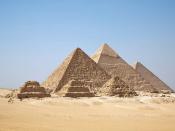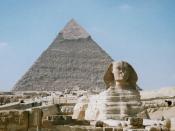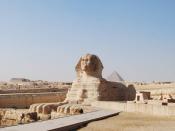Artwork is an expression of many different factors relating to its society. Apart from the artist himself, the ideas of the time period, culture, and location of the particular piece contribute greatly to the present day interpretation of the artwork. The importance in studying art is apparent when speaking of the influences throughout various cultures. Noticing similarities in artwork throughout different locations is remarkable to the growing knowledge of ancient cultures and their interactions. Before understanding the similarities between to two pieces of art from different societies it is necessary to examine each piece individually.
Statues from Egypt were created with a rigid perspective of the positioning of the human body. The statue of Mycerunus and his Queen, from Giza, 2500 B.C.E., is an example of such a stiff and immobile sculpture. Although just under five feet tall, the figures provide the viewer with a feeling of power and signifigance.
This idealized style portrayed the pharaoh as physically strong with a disregard to the actual physical appearance of the king. The statue is attatched to the stone block from which it was carved and there are no free spaces between the limbs. The left legs appear to be stepping out from the body yet, there is no motion, or shift of weight, in the hips or torso.


